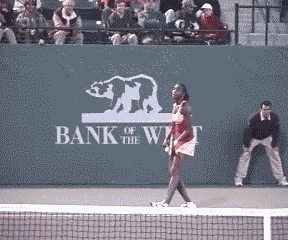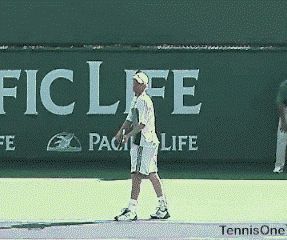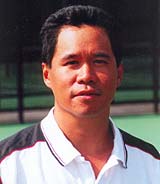|
TennisOne Lessons Improve Your Topspin Serve: Five Fun Drills Doug Eng EdD, PhD Of all strokes, perhaps the serve produces the most variations in styles. We see different rituals, different backswings, and different stances. However the differences, many club players struggle with the toss, spin, and balance. Others struggle with the second serve, especially under pressure. A common problem at almost any level is consistency on the topspin serve.
The topspin serve can be a challenge, mostly due to a couple reasons. First, many intermediate and beginner players (NTRP rating of 3.5 and below) serve with a forehand grip instead of a continental or eastern backhand grip. It is difficult to produce a good topspin with the forehand grip since the racquet face tends to open up on the backswing. Most players with the forehand grip push the ball upwards rather than brush the back of the ball. The continental grip makes it easier to go up on edge with the racquet head and brush the back of the ball. The eastern backhand grip further increases the spin but can limit power. Second, many intermediate players using the continental grip tend to open the racquet face by letting the wrist extend backward or let the palm open up to the sky. The effect is quite similar to the forehand grip. Sometimes the palm and wrist flip back as the racquet drops behind the head. Sometimes too long of a backswing contributes to the racquet face opening up. At any level of play, you can improve your topspin serve. Many players get bored and don’t work enough on the serve. To add a little excitement, I will show five fun, creative drills for your topspin serve. These drills are equally fun for the 3.0 or 5.0 player.
Serve With the Edge of the Racquet I show this simple drill first since it eliminates the two culprits for not producing enough topspin: the open racquet face and the forehand grip. Many players feel the continental grip isn’t comfortable, are afraid of missing the ball, and consequently turn the strings early to contact the ball. Turning the strings is necessary at the contact point but during much of the upswing the racquet remains up on edge. Using a continental grip, start the racquet on your shoulder. For better results, you can hold the racquet at the throat rather than the grip. That allows you to feel the edge of the racquet better. Toss the ball upwards and extend the racquet to the ball. Hit the ball with the edge of the racquet. It’s a fun exercise and easier than it might first appear. Trap the Ball Behind Your Head
This second drill also eliminates the forehand grip and the open racquet face. Many people have the natural tendency to open the racquet face on the backswing when the racquet drops behind the head. When the palm and the racquet face open up, the service motion becomes more of an upwards push rather than a brushing motion. When you trap the ball on your head with the strings, your palm and racquet head are in a neutral position. First stand at the service line or farther inside. Hold the racquet at the throat to give yourself a better feel for the continental grip. Stand slightly sideway to the net, and with your racquet strings, trap the ball halfway behind the back of your head and your right ear (if you are right-handed). Then brush straight up with the racquet and the ball will go over your head with topspin and over the net. Follow-through upwards after contact to pronate the palm down. Sit and Serve
Some tennis players have long or complicated backswings which lead to an open racquet face. In such swings, the serve is either pushed or the racquet never catches up to the proper contact point. First sit cross-legged at the service line (or a bit farther back) facing the net post to your right (if you are right-handed). By sitting down, you take out the complicated backswing errors that are often made. Your backswing will be simpler and more fluid. You should find it harder to flip your wrist back on the backswing. The sitting serve also forces you to hit upwards as the net will be higher. Stand Sideways and Serve Many players open up the hips or shoulders too early at contact which flattens out the ball. Some players let the right foot slide too far forward and even ahead of the left foot which opens up the hips too much. When the hips and shoulders open up too early, you lose much of your spin and instead, flatten out the serve.
Interestingly, Tim Mayotte, one of the top ATP players in the 1980s and 1990s once mentioned that he struggled with consistency. While he was on the tour, no one corrected his error with the feet and hips which would open his shoulders and reduce the topspin. Venus Williams also opens up early which makes her serve inconsistent. Today, with the aid of high speed digital cameras, and understanding about biomechanics, we can easily detect these kinds of flaws.
This drill can be done at the baseline. Just simply stand sideways to the net. Toss the ball slightly behind your head and serve upwards with the brushing motion. Using an abbreviated backswing helps isolate the brushing topspin motion. Do not turn the hips nor follow-through much after you hit the ball. Thinking of a hook shot in basketball might help you visualize this drill. Serve Over the Fence This drill helps you hit upwards and modify your toss if you tend to put it too far in front. Stand outside the tennis court fence about four to six feet away from the fence. Try to serve over the fence and into the court. This drill is the ultimate in learning to hit upwards on the serve. Make sure you are not next to a fence post since the ball can ricochet very fast off the post creating a dangerous situation. In the first few tries, you might hit into the fence frequently so try using an eastern backhand grip and toss the ball over your racquet shoulder. Those two tips will help you hit more upwards. Wrap-Up These drills are definitely fun to try. Sometimes a bit of creativity and fun can help you play better tennis. When you get bored, it is harder to enjoy your tennis and stay motivated. Try these drills and have a bit of fun improving your topspin serve and your tennis. Good luck this spring! Your comments are welcome. Let us know what you think about Doug Eng's article by emailing us here at TennisOne.
Doug Eng EdD PhD coaches men's tennis at Tufts University. During the summer, he directs at the Tennis Camps at Harvard. He has received divisional Pro of the Year honors from the PTR and USPTA and several national award. Doug completed the USTA High Performance Coaches program and frequently runs educational and training programs for coaches. Doug also writes and speaks on tennis and sport science. |



